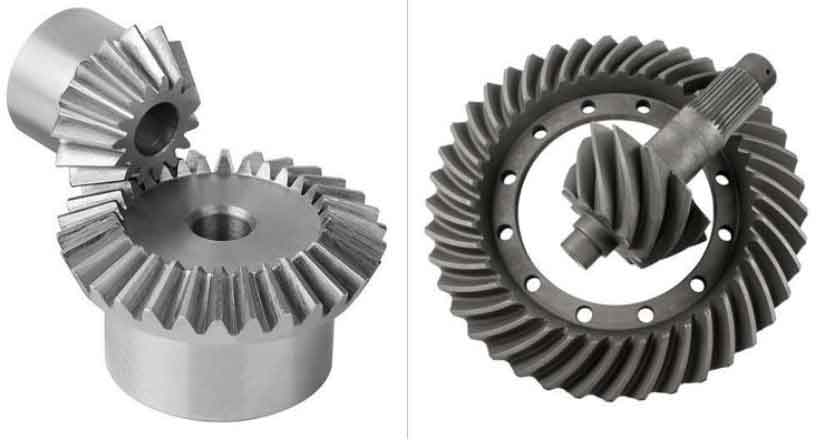Spiral bevel gears and straight bevel gears are both types of bevel gears used in various applications. While they share some similarities, they also have distinct differences in their performance characteristics. Let’s conduct a comparative analysis of their performance:

1. Tooth Engagement:
- Spiral Bevel Gears: Spiral bevel gears have helical teeth that engage gradually and smoothly. This gradual engagement results in lower impact and vibration during meshing, reducing noise and providing a more comfortable operation.
- Straight Bevel Gears: Straight bevel gears have straight-cut teeth that engage abruptly. The instant tooth engagement can lead to higher noise levels and impact forces, making them noisier compared to spiral bevel gears.
2. Load Distribution:
- Spiral Bevel Gears: The helical tooth design of spiral bevel gears allows for multiple teeth to be in contact at any given time, resulting in better load distribution along the tooth surface. This feature leads to increased load-carrying capacity and improved durability.
- Straight Bevel Gears: Straight bevel gears typically have fewer teeth in contact at any given time compared to spiral bevel gears, resulting in higher contact stresses and reduced load-carrying capacity.
3. Efficiency:
- Spiral Bevel Gears: The gradual meshing action of spiral bevel gears leads to reduced sliding friction during gear engagement, contributing to higher gear efficiency.
- Straight Bevel Gears: Straight bevel gears have a higher sliding friction during meshing due to their instantaneous tooth engagement, resulting in lower gear efficiency compared to spiral bevel gears.
4. Noise and Vibration:
- Spiral Bevel Gears: Spiral bevel gears are quieter due to their gradual tooth engagement and better load distribution, resulting in reduced noise and vibration during operation.
- Straight Bevel Gears: Straight bevel gears are noisier due to their instantaneous tooth engagement and higher impact forces during meshing.
5. Torque Transmission:
- Spiral Bevel Gears: Spiral bevel gears can handle higher torque loads due to their improved load distribution and higher gear efficiency.
- Straight Bevel Gears: Straight bevel gears have lower torque-carrying capacity compared to spiral bevel gears.
6. Application Flexibility:
- Spiral Bevel Gears: Spiral bevel gears are more versatile and can be used in a wide range of applications, including automotive transmissions, aerospace systems, and industrial machinery.
- Straight Bevel Gears: Straight bevel gears are often used in applications where noise is not a concern, and they are suitable for simple, low-load applications.
Conclusion: In conclusion, the choice between spiral bevel gears and straight bevel gears depends on the specific requirements of the application. Spiral bevel gears offer advantages such as smooth tooth engagement, better load distribution, higher efficiency, and reduced noise, making them suitable for applications that demand precision, durability, and low noise levels. On the other hand, straight bevel gears are simpler in design and are used in applications where noise and impact forces are not critical factors. Ultimately, the selection of the appropriate gear type should consider the specific application’s performance, efficiency, and noise requirements.
